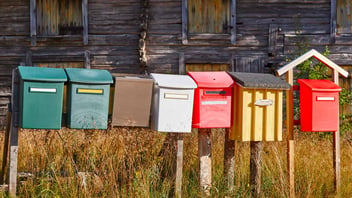Message less, but communicate more
Nico LarsenIn team collaboration, communication is your number one tool. Leaders should build organizational structures and implement technologies that support communication. Nothing beats face-to-face communication, but let's face it, your face-to-face capacity should be spent on making new connections and shaking hands on things that move things forward. Between these moments a ton of messaging takes place to organize and collaborate.
This article covers how you can use Hailer to master how you communicate with people around you.
First, we must run through some obsolete technologies for modern collaboration. Mail is too slow, nobody wants to print and put papers in envelopes. Not to mention buying stamps and taking the envelope to a mailbox.
That’s quite obvious, but the next one is not as obvious to many. E-mail is fast and flexible, but that’s both its biggest strength and weakness. You don’t have any control over your inbox and the same applies to everyone else and their inboxes.
Many teams are shifting to chat channels in systems such as MS Teams or Slack, which are better for bringing teams together. Different team chats can be handy, but if not controlled and managed the channels easily become filled with noise as various topics are discussed simultaneously. Its like having several radios on at the same time, which makes it hard to focus on the critical things. Like all other tools offering discussion channels, Hailer also offers the possibility for group chats. These include the typical tools for any modern chat app:
- Include as many people as you want
- Support for all file types
- A way to navigate all media and files sent in each discussion
- Reply to messages
- React to messages
- Delete or edit your own messages
- Possibility to mute individual channels
- Possibility to leave discussions
- Open video meeting directly in a group (collaboration with open source project Jitzi meet)
The group chats in Hailer can also be something way more powerful. We call these discussions activity discussions. This is a powerful tool for leaders to solve the problem with lots of noise occurring in different channels.
The most significant advancement with activity discussions compared to just channels is the radical focus of context. Instead of a channel called “Sales Team” you can now have a workflow for all your deals that opens up a separate discussion for each sales case. This allows people to be part of only the things that are relevant to them. Or for as long as the thing is relevant. Joining, leaving, and adding people to discussions is a team effort that helps everyone focus. Contextual channels reduce message length and the number of messages by up to 50%.
Other things that add value are automatic updates and data on the activity card that can be opened up directly from the discussion.
Using activity discussions requires a shift in mindset for all involved to think context rather than who needs to receive a message. This is the key thing that all involved should consider: think WHAT rather than WHO every time a new message needs to be sent.
Observing team messaging offers a good way to develop organizational processes. This is done by asking a single question for each new things that is being discussed:
“Can an improvement in the workflow remove the need for this message?”
The activities section includes many tools to improve workflows, data structures, and automations, but that’s another topic.
In summary, the activities section is a place for strategic forward-looking work to make the organization work more smoothly, while the discussion section is where the tactical implementation of the day-to-day operations takes place.
Hailer offers another tool for culture building and more critical messaging. This tool is called the Feed. The Feed allows for people to publish news and articles, but it can also be used to create automatic updates from the activities. Incoming deals, completed projects, incident reports, etc can all be automated.
As someone who develops an organization, the feed is an ideal tool to generate a sense of belonging for all involved. This is not a party trick though as new content needs to be created to drive people to the feed. Some people will eventually start to create content, but it's important to remember that not all people are comfortable producing content. The feed can be used to replace e.g. trip reports or mass emails to the organization. Anyone can comment on feed content.
Finally, after a clear structure and people start communicating on Hailer, everyone can adjust their notifications to match how they work. This is done with
- In-app notifications: silent notifications that appear on the bell icon inside Hailer. When clicking on an in-app notification, you will be taken to the place that triggered it. One way to keep your finger on your organization's pulse to receive notifications when certain things happen is to follow phases. This is done from the activities page. Here you can e.g. have a sales workflow with a phase called “New leads”. By clicking on the notification bell in the phase, you will receive an in-app notification every time a new lead is added. This works in the same way for all workflows and datasets across Hailer
- Push notifications, or the kind of notifications that make your phone beep or vibrate. These can also be used on desktops. At the time of writing this user-written messages create push notifications that each user can either turn on or off, but a more advanced Notification Center is in the works.



